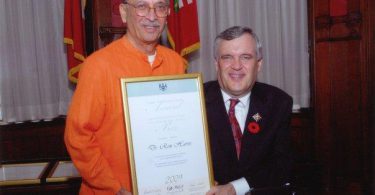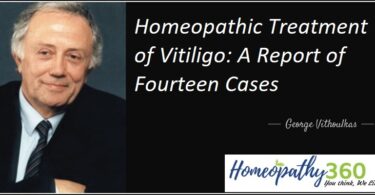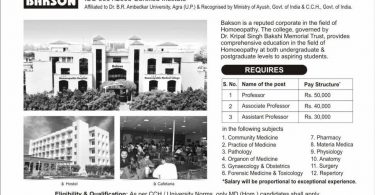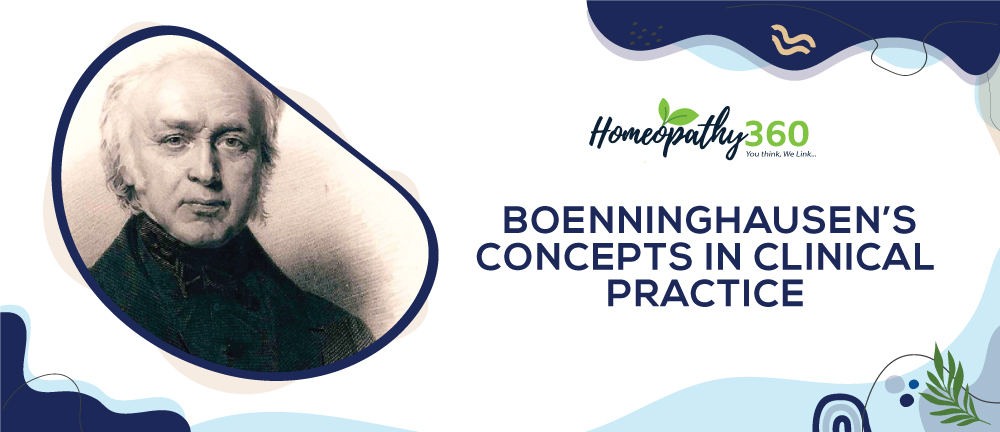
ABSTRACT:
This paper intends to throw light on Boenninghausen’s method and his less often used repertory: Boenninghausen’s Therapeutic Pocket Book. This is one of the first repertories and is considered an authentic work of Boenninghausen. However, Therapeutic Pocket Book is less used in practise because of certain points of criticisms. The practical use of Boenninghausen’s methods has been illustrated with a clinical case study in which it is observed that the homoeopathic treatment done using Boenninghausen’s method is able to reduce the intensity of pain in patients with urolithiasis.
Keywords: Boenninghausen’s Therapeutic
Pocket Book, totality of
symptoms, clinical case, repertory
INTRODUCTION:
Boenninghausenʼs work is nearly forgotten from the collective psyche of modern-day homoeopaths. This is largely due to Kentʼs influence on present day practise in terms of the great importance he gave to the mental state of the person and also his criticism on the process of generalisation. This essay is an attempt to revive Boenninghausenʼs central philosophy and its practical application exactly as was done by the Boenninghausen himself.(1)
Every individual has certain distinguishing peculiarities, which give him/her individuality. While in general contour, he is similar to other members of his race, he has, in addition, some exceptional points or traits, which show an unmistakable difference between him and his fellow-men. These peculiarities in health, he retains when he is sick. These symptoms serve to detect disease.
The following fundamentals, as preached by Hahnemann, were accepted by Boenninghausen.
(1) The patient, not his parts or organs, is the one who is sick.
(2) Signs and symptoms are the only things that may be known about a disease.
(3) Symptoms are the sole reliable guide to selecting a therapy.
(4) The simillimum is defined by unique, distinguishing, individualising symptoms in the case rather than common symptoms.
“The more striking, singular, uncommon, and peculiar (characteristic) signs and symptoms……,” Hahnemann says, alluding to as the main characters of a diseased person to be noted.
Boenninghausen was dissatisfied with the master’s explanation and expected a more thorough explanation. However, after three years of silence from the homoeopathic community, Boenninghausen attempted to provide what he regarded to be a reasonable response to the question of how to classify symptoms.
Boenninghausen, went further in his search for a simple yet systematic method, to capture all aspects of the patient. In an essay, “Concerning the Characteristic Value of Symptoms,” he writes that in his literary studies he came across some verses in the form of a hexameter dating to the beginning of the twelfth century attributable to theological scholastics. (2)
THE HEXAMETER
It was used by the monks to
judge “a moral disease,” that is to say, “the peculiarity and grievousness of
various moral lapses.” It immediately struck Boenninghausen that it contained “all the essential momenta which are required
in the list of the complete image of a disease.”
The verse is: “Quis? Quid? Ubi? Quibus auxiliis? Cur? Quomodo? Quando?” These seven are translated: “Who? What? Where? What else? Why? What modifies? When?”
- Quis? or WHO?
It includes gender, age, bodily constitution, temperament (personality) and individuality (nature). “The greatest and most important variations are here found mostly in the states of the mind and spirit…”
Hahnemann’s attentive student, Boenninghausen, repeats the words of his Mentor, “…and in all cases of disease we are called upon to cure, the state of the patient’s disposition is to be particularly noted along with the totality of the symptoms…”. Clearly, Boenninghausen emphasised the importance of the mental state. He wrote, “in all such cases [states of the mind and spirit] we have all the more cause to fathom these states with all possible exactness, as in them frequently the bodily ailments recede to the background…”
2.Quid? or WHAT?
This refers to the disease, its nature and peculiarity and the need for pure observation. The homoeopathic medicine, he stated, “must correspond with the common genius of the disease” which is to say it must match the salient, characteristic symptoms.
The word, ‘characteristic’ is used frequently in homoeopathic literature to mean a distinguishing trait or quality.
3. Ubi? or WHERE?
This part refers to location. Pure observations, which are characteristic of Hahnemann’s method, have established that homoeopathic medicines can benefit certain parts of the body and are actually useful. As long as the place plays a role, Bönninghausen cannot be accused of ignoring it. He soon realised that various medications could affect one or the other side of the body, etc. It was sensation and modality that Bönninghausen generalised. A well-known Sepia symptom of Boenninghausen was “sores on the upper joints of the fingers and toes,” . “All homoeopaths know the effectiveness of sepia for these joint ulcers.” It’s strange that modern homoeopaths don’t mention this symptom.
4.Quibus auxiliis? or CONCOMITANT (accessory) symptoms.
These are symptoms accompanying the main complaint Boenninghausen was quick to point out that “those ailments which are wont to appear as constant concomitants or at least as usual in the disease” can be omitted unless they are “distinguished by some rare peculiarity.”
5.Cur? or WHY?
Causes of illness vary and often determine treatment. Several proximal causes: trauma, toxic exposure, drugs, emotions, “never well since”, exposure to bad weather (cold and rain, sun, etc.).
Miasm: psora, sycosis, syphilis.
6.Quomodo? or MODALITIES (modifying influences)
Often the most useful of the seven momenta. It includes: food and drink, weather, position, heat, cold, etc.
7. Quando? or WHEN?
Time or onset; time of aggravation; sequence of events.
Quando can often be included under quomodo unless it refers to the sequence of events or chronology.(2)
TOTALITY OF A DISEASE:
Boeninghausen says, “when the symptoms of the case have been gathered and the totality has been found we have all that can be known of the disease. It exists then in a form to which other different general names have been applied. The symptom picture, the case, the individuality of case…
…The totality in homoeopathic practise is the true diagnosis of the disease and at the same time the diagnosis of the remedy. The totality eliminates all the theoretical elements and speculations of traditional medicines and deals only with the actually manifested facts. These facts it assembles, not according to some arbitrary or imaginary form but according to natural order.”(3)
The main purpose of a homoeopathic case study is to formulate a “whole symptom” for prescribing homoeopathic simillimum. However, it may be difficult to obtain complete symptoms because the patient may not be observing the symptoms, may not be able to provide details of the symptoms, or may not be able to identify the missing elements of some symptoms.(3)
Dr Stuart Close says, ‘Boenninghausen’s Therapeutic Pocket Book was devised primarily to deal with just such cases. Boenninghausen first conceived the idea of completing these symptoms partly by analogy, and partly by clinical observation of curative effects. He discovered that many if not all of the modalities of a case were general in their relation and were not necessarily confined to the particular symptoms with which they had first been observed’ (4)
COMPLETE SYMPTOMS:
Based on this model, Boenninghausen states that at least four elements are required to complete a symptom: location, sensation, modality, and concomitants. He says that totality is not only the whole symptoms total, but it is the patient’s “one grand symptom” in itself. This “Grand symptom” consists of location, sensation, modality, and concomitants. It represents the clinical picture of the entire individual and his individual organs.(3)
In the preface of Therapeutic Pocket Book, Bönninghausen describes the term “complete symptoms.” For him, this complete symptom consisted of four parts, as mentioned above. This overall symptom by Bönninghausen reflects the clinical picture of the patient. This pattern of illness in the patient may correspond to songs and melodies. Each element of this complete symptom is like a single isolated note. All notes (components) are essential to creating a complete “melody”. Not only are their presence essential, but the way they come together determines the individuality of the melody. Boenninghausen named this “song” about an individual illness “grand symptom of the patient.” The word “symptom” here also means portrait.(5)
Boenninghausen emphasised the value of the completed symptom (by locality, sensations and conditions of aggravation and amelioration) but added a fourth requirement: the concomitant symptom: the unreasonable attendants of the case. The word concomitant means existing or occurring together or attendant circumstance. They have an actual relationship in that they exist at the same time and in the same patient. Given simply a pain of a certain definite character, in a definite locality or organ a condition of aggravation or amelioration, and a differentiating factor— the so-called concomitant or accompanying symptom—and symptom—and the remedy can be found. (6)
Furthermore, in reality there are obstacles to achieving this Grand Symptom. To overcome this obstacle, Boenninghausen took fragments of incomplete symptoms presented in different anatomical regions and stitched them together to complete the symptomatology
CASE STUDY
Mr. XY of age 54 came with the complaints of intense burning pain over the left side of abdomen since that day morning. There was increased urging to pass urine but couldn’t void urine completely and passes drop by drop. Pain radiates from the left loin to groin region. Pain aggravated when walking, standing. Pain in urethra as if urethra being tore when passing urine. The patient was restless with profuse sweating of the forehead.
PHYSICAL GENERALS
- Appetite: decreased appetite because of pain.
- Thirst – Reduced, 1 – 1.5 litres of water / day
- Cravings – Sweets++
- Aversion – Meat
- Perspiration – increased,
- Bowel habit – Once a day. Regular.
- Bladder habit – 8-10 times per day since yesterday with painful burning micturition.
- Sleep – Disturbed due to complaints.
- Dreams – Nothing specific
- Thermal state – hot patient
TOTALITY OF SYMPTOMS:
- Burning pain over the left loin to groin since morning
- Ineffectual urging to pass urine
- Pain aggravated by standing, walking
- Pain in urethra as if urethra being tore when passed urine
- Profuse sweating all over the face
- Appetite and thirst reduced
Analysis and evaluation of symptoms:
| MENTAL GENERALS | PHYSICAL GENERALS | PARTICULARS |
| Anxious | Craving for sweetsAversion to meatSleep – disturbedSweat: increased, especially over forehead | Burning pain over the left loin to groin since morningIneffectual urging to pass urinePain aggravated from standing, walkingPain in urethra as if urethra being tore when passed urine. |
Miasmatic Analysis (8)
| PSORA | SYPHILIS | SYCOSIS |
| Anxious Craving for sweets Sleep – disturbed Sweat especially over forehead Burning pain over abdomen Ineffectual urging to pass urine < standing | Aversion to meat | Renal calculi Radiating pain from loin region Sweat increased |
Dominant miasm : Psora
Rubrics as taken from THE THERAPEUTIC POCKET BOOK:
- BACK, LUMBAR AND SACRAL REGION
- BACK, LEFT SIDE
- SENSATION, BURNING INTERNALLY
- MICTURITION, INEFFECTUAL
- MICTURITION,BY DROPS
- SENSATION, SCRAPED FEELING
- AGGRAVATION, WALKING
- AGGRAVATION, STANDING
- FEVER, SWEAT ON SPECIAL PARTS (5)
Here the rubric for sweat on special parts was selected as the concomitant symptom.
REPERTORIAL RESULT(7):
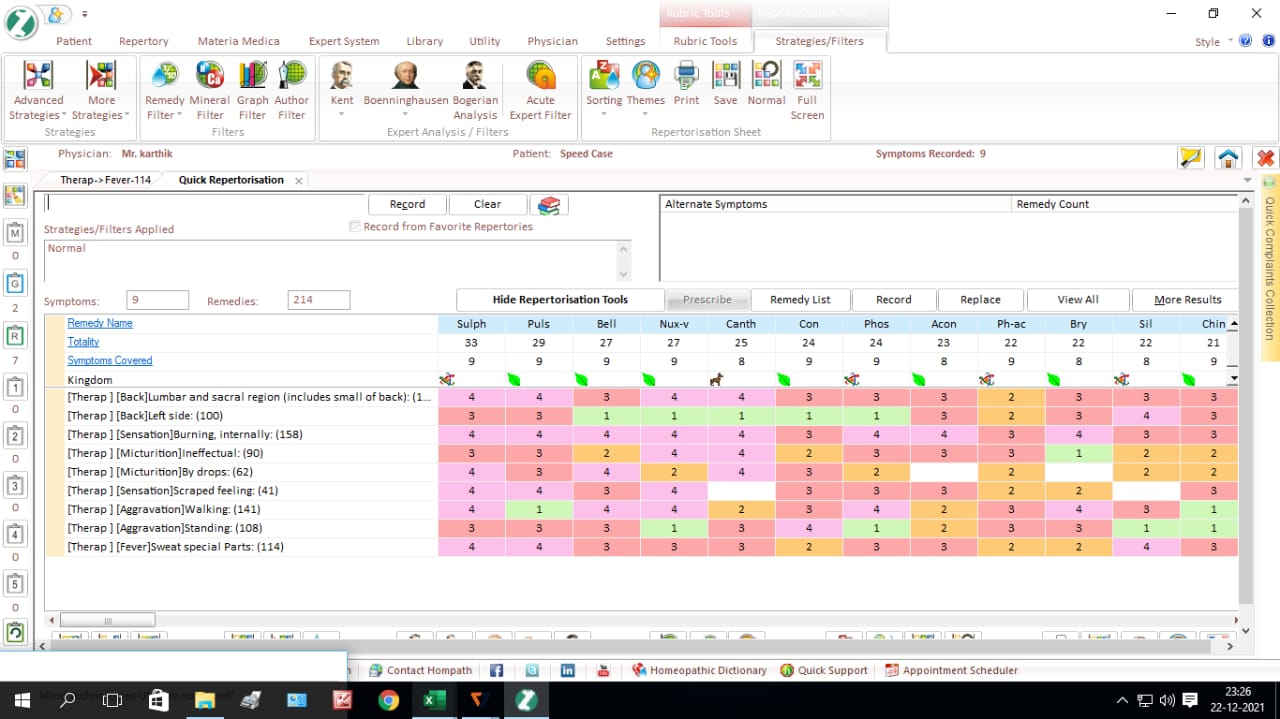
PRESCRIPTION:
Sulphur 200 /1 dose/(1-0-0)
(burning pain, symptoms aggravated by walking, standing, scraped sensation while passing urine, desire for sweets, perspiration of single parts) (9)
(Potency and dosage- best results in higher potencies and in infrequent dosage(9)
the sudden acute pain and its intensity pointed out in selecting this potency)
Placebo (4-0-4) /1 day.
FOLLOW UP:
| S.NO | SYMPTOMS | PRESCRIPTION |
| 1. | Patient felt slightly better. Pain over the loin region reduced. Sweating reduced | Placebo (3- 0 – 3) AF/1 day |
| 2. | Patient felt better, pain while passing urine decreased. Slight pain present radiating from the loins. Sleep improved. | Sulphur 200/ 1 dose (1-0-0)BF (Even correctly chosen medicine with action of long duration needs to be repeated, according to circumstance, to achieve success –§ 248)(10) Placebo (3-0-3)/2 days, AF |
| 3. | Patient felt better, no pain while passing urine. Pain radiating from loins also was absent | Placebo (3-0-3)/ 4 days, AF |
| 4. | Patient felt better with all complaints | Placebo (3-0-3)/ 7 days, AF |
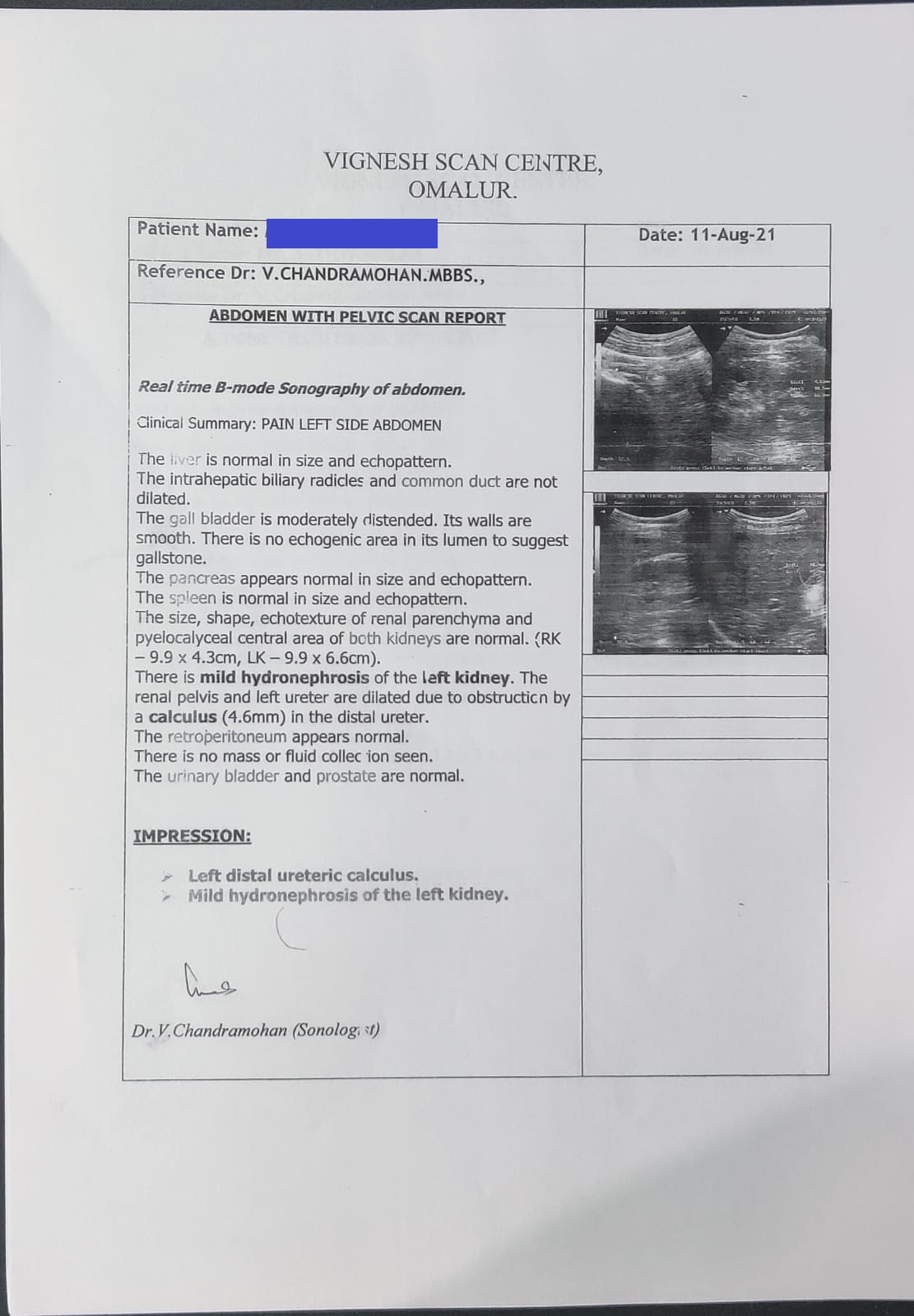
Before treatment:
After treatment:
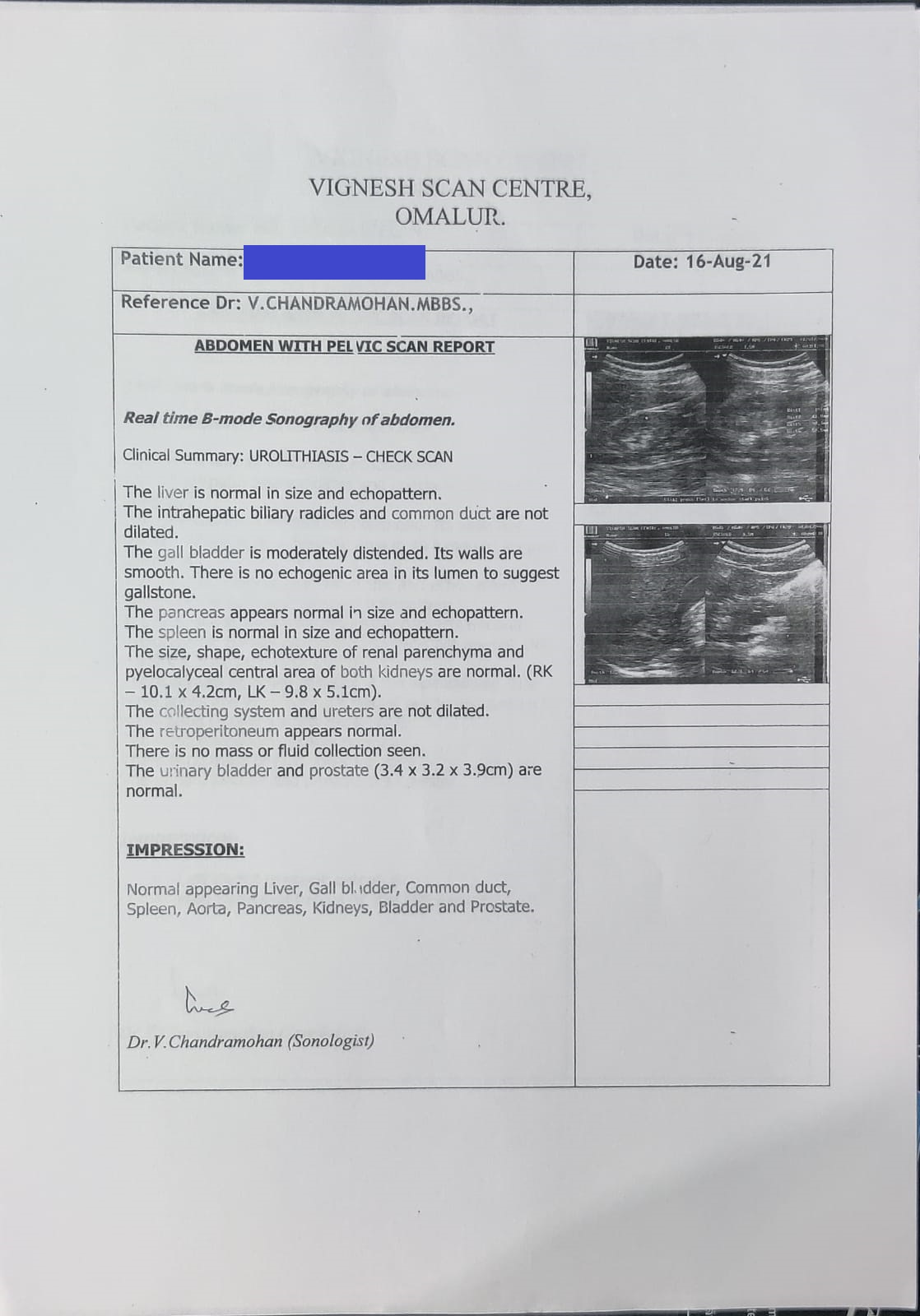
CONCLUSION:
According to Boenninghausen, conquering the full portrait of the patient can be attained by knowing the complete symptoms present. To attain it, his concept of grand generalisation plays an important role.
In the above case, homoeopathic medicine helps in removing the cause, ie. The stone lodged and removes it completely via urine so that the pain stoped. The patient started Homoeopathic medicines and within 2 days,the stone was expelled out, Pain was releived. Sudden cure in cases like these will increase the common man, who is canvased by medical industry, to follow homoeopathy blindly and whole heartedly.
In these times where consultation via phone has increased, reaching out to the patient to attain all his mentals have become a difficult task. Its right to say that we should travel the now less employed brilliant methods formerly used by our masters. Therapeutic Pocket Book, when used perfectly is still one of the best repertories that have been donated to homoeopathy, by Boenninghausen.
REFERENCES:
- Tiwari SK. Essentials of Repertorization: A Comprehensive Text Book on Case Taking and Repertorization for Practitioners and Students. B Jain Publishers; 2000
- Thakar M. Rediscovering the Relevance of Boenninghausen and Bogerʼs Concepts–Part II. Homœopathic Links. 2013 Mar;26(01):25-33.
- Von Boenninghausen C, von Boeninghausen CM. The lesser writings. B. Jain Publishers; 2002.
- Allen TF. Boenninghausen’s Therapeutic Pocket Book. 5th American ed. New Delhi, India: B. Jain Publishers; 2009
- Katarmal D. Boenninghausen’s Therapeutic Pocket Book and Musculoskeletal Pain. Homœopathic Links. 2019 Jun;32(02):088-94.
- Hompath Classic Software
- Banerjea SK. Miasmatic prescribing. B Jain Pub Pvt Limited; 2007.
- Boericke W. Pocket Manual of Homoeopathic Materia Medica & Repertory: Comprising of the Characteristic and Guiding Symptoms of All Remedies (clinical and Pahtogenetic [sic]) Including Indian Drugs. B. Jain publishers; 2002.
- Hahnemann’s Organon of medicine,6th edition, B.Jain publishers,New Delhi.
ABOUT THE AUTHORS
Dr J. Senthilkumar, B.H.M.SM.D(HOM),Professor, PG Guide ,Head of Department ,Department of Repertory, Vinayaka Mission’s Homoeopathic Medical College & Hospital, A Constituent college of VMRF-Deemed to be University, Salem, Tamil nadu.
Dr R .Sri Vaishnavi, B.H.M.S, M.D(HOM) Assistant Professor, Department of Repertory, Vinayaka Mission’s Homoeopathic Medical College &Hospital, A Constituent college of VMRF-Deemed to be University, Salem, Tamil nadu.
Dr Karthik R S ,B.H.M.S, Post Graduate Student ,Department
of Repertory, Vinayaka Mission’s Homoeopathic Medical College & Hospital, A
Constituent college of VMRF-Deemed to be University, Salem, Tamil nadu.


